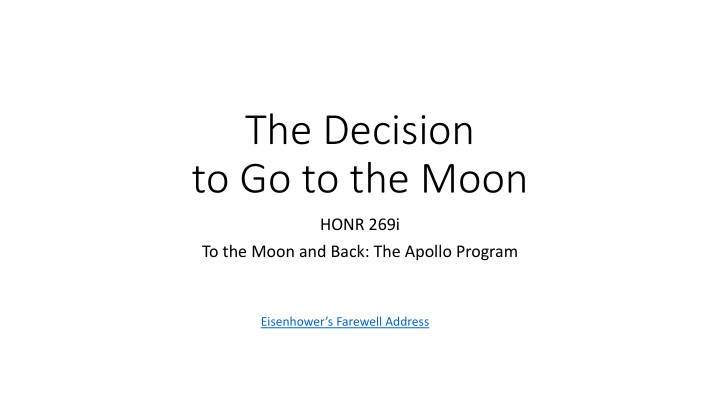



The Decision to Go to the Moon HONR 269i To the Moon and Back: The Apollo Program Eisenhower’s Farewell Address
Dramatis Personae • Nikita S. Khrushchev, First Secretary of the Communist Party (USSR) • John F. (“Jack”) Kennedy, President • Lyndon B. Johnson (“LBJ”), Vice President • James E. (“Jim”) Webb, NASA Administrator • Robert S. (“Bob”) McNamara, Secretary of Defense • Theodore C. (“Ted”) Sorenson, Special Counsel to the President • Jerome B. (“Jerry”) Wiesner, Science Advisor • Robert S. Kerr, Senator • George M. Low, NASA Chief of Manned Space Flight • David E. Bell, Budget Director
Chronology • 4 th Kennedy-Nixon Debate (October 21, 1960) • Kennedy elected (November 8, 1960 • NASA: Low Committee formed (January 5, 1961) • Inaugural address (January 20, 1961) • NASA: Webb starts as Administrator (February 14, 1961) • First Soviet manned orbital flight (April 12, 1961) • Bay of Pigs invasion (April 17, 1961) • NASA: Fleming Committee formed (May 2, 1961) • Joint session of Congress (May 25, 1961) • Vienna Summit with Khrushchev (June 4, 1961) • $1.8 Billion authorized for NASA (July 21, 1961)
Source: DoD Comptroller
Fleming Report (June 16 1961)
A “Rational Actor” Perspective • American leadership was essential to the American way of life • And American leadership demanded leadership in space • The Soviet Union had much larger rockets in 1961 • And they could probably make them large enough to fly around the moon • Landing on the Moon would require 10 times the rocket thrust • And the Americans had started design work on what became the F-1 in 1955 • The American economy was far larger than the Soviet economy • So the Americans would have a good chance to win a “moon race”
A “Bureaucratic Politics” Perspective • NASA • Launch vehicles capable of reaching anywhere in the solar system • Advanced human spaceflight technology • Balanced program • Department of Defense • Preserving the aerospace industrial base • Investments in solid-fuel rockets • Gaining human spaceflight experience • Politicians • Strengthening Kennedy’s negotiating position at the Vienna summit • Leadership in the eyes of the world, and in the eyes of the American people • Special interests
Discussion Groups • Day, Space Review (“Pay No Attention to the Man with the Notebook …”) • A journalist sitting on discussions on how to react, 2 days after Gagarin’s launch • Launius Chapter 2 (“Kennedy and the Decision to Go to the Moon”) • A critical view, casting Kennedy as taking a page from Khrushchev’s playbook • Kennedy Recording (“Meeting on the Presidential Budget”) • A secretly made recording in which Kennedy explains why Apollo is important • Logsdon (“The Apollo Decision and its Lessons for Policy-Makers”) • An appreciative view, articulating four factors that make such decisions possible
Logsdon’s Apollo-Like Decision Circumstances 1. The objective must be known to be technologically feasible, with a high degree of probability, at the time the decision … is made 2. The objective must have been the subject of sufficient political debate so that … potential sources of support have time to develop 3. Some dramatic “occasion for decision” must occur to create an environment in which …. policies to achieve it become politically feasible. 4. There must be in leadership positions ... individuals … who have the political skill to choose the situations in which such activities can be initiated.
Recommend
More recommend